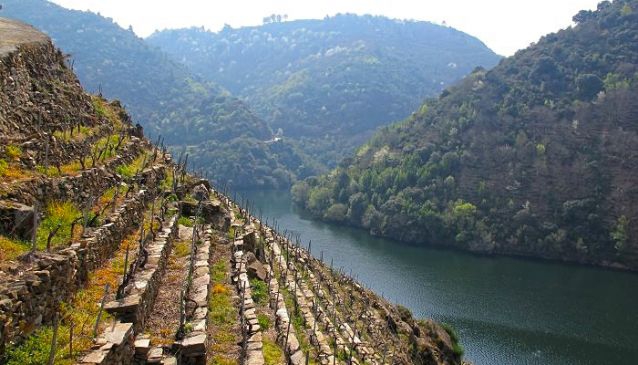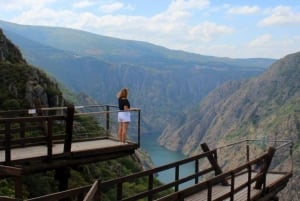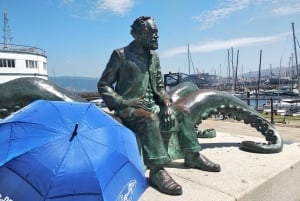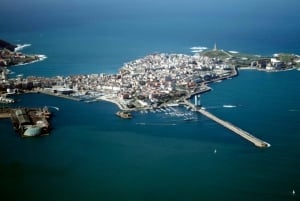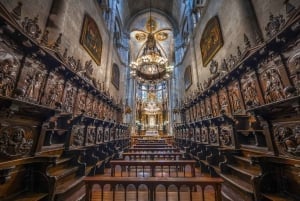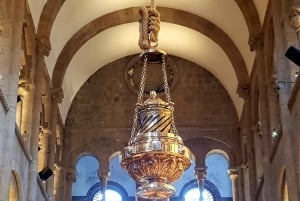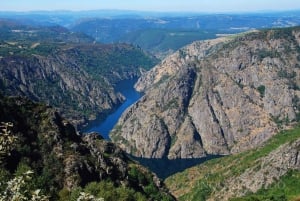Ribeira Sacra in Galicia
The natural beauty of the Ribeira Sacra justifies a detour from the well-trodden Galicia route
Book Top Experiences and Tours in Galicia:
If youʻre booking your trip to Galicia last minute, we have you covered. Below are some of the top tours and experiences!- From Santiago: Ribeira Sacra Tour & Boat Trip
- Vigo: Private Walking Tour with local guide
- Ría de Arousa: Boat Ride to Mussel Farm with Tasting
- A Coruña: Private Walking Tour with Local Guide
- Lugo: Cathedral of Santa Maria Entry Ticket and Audio Guide
It is a small wonder that the Ribeira Sacra has not yet achieved a ‘must visit status’ both within and outside Spain. The area boasts some of the most spectacular gorge scenery in Europe. Terraces of vines perch precariously on improbably steep slopes and a multitude of medieval monasteries, churches and chapels overlook the rivers or nestle in gentler terrain nearby. Lying northeast of Ourense the Ribera Sacra is located deep in the interior of Galicia, yet can be reached in less than an hour and three quarters from Santiago de Compostela.
The term Ribeira Sacra, meaning ‘holy river bank’, is used to refer to the lands that border the confluence of the rivers Sil and Miño, and includes parts of the provinces of both Ourense and Lugo . From early Christian times hermits and then monks settled in the area, building monasteries which exerted an influence over the whole of Galicia. The canyons of both rivers are impressive but those of the Sil are steeper, rockier and more inaccessible than the greener, gentler banks of the Miño, which have lent themselves more to human habitation.
Wine production has been central to the fortunes of this area since Roman times when the first terraces were carved out of the rock by slaves and one of the delights of the area is being able to see so clearly how the cultivation of grapes has shaped the landscape. Following the expulsion of the Islamic invaders in the 15th century, the monasteries gave a fresh impulse to the production of wine in the area, encouraging people to re-settle there. Today, after the ravages of phylloxia and the civil war, wine-making in the Ribera Sacra is thriving: three million bottles are produced every year and many of its bodegas or wine cellars have won both international and national awards. The combination of native grape varieties, slate and granite soils, and the microclimates of the rivers and their terraces produce excellent growing conditions, for distinctive red wines in particular, which resemble no others in or for that matter the rest of Spain.

Places to visit
There are so many things to see and do in the Ribeira Sacra that it would be impossible to cover them all here. This article focuses on some of the highlights of the western section of the area as this is perhaps the direction from which you are most likely to approach. One of the joys of the Ribeira Sacra, though, is exploring the small villages and discovering for yourself the traces of its Roman and medieval past which are as evident in its tiny churches, bridges and stone crosses as in the grander examples of its architecture noted below.
Unless you are planning a visit of several days there won’t be time to visit the dozens of medieval monasteries and churches in the area. Here is an eclectic mix which hopefully captures the variety of what is on offer. The monastery of Santo Estevo , which is now a state-run Parador, is reputed to be one of the best examples of Romanesque Galician architecture, but its setting and the views down to the river on their own make it worth a visit. Set amongst a grove of chestnut trees, the atmospheric 13th century buildings of Santa Cristina capture perfectly the peace and tranquillity of the Ribeira Sacra and the vivid frescos of its church are stunning. San Pedro de Rocas offers a striking contrast; its crude chapel carved into the rocks and tombs chiselled out of the chapel’s floor give proof of its status as the earliest hermitage in Galicia. Of the many medieval monasteries and religious buildings that Panton possesses, Monasterio de Ferreira de Pantón is of particular interest because it continues to house a closed order of nuns. Visit the shop to buy typical home-made cakes and biscuits but don’t expect to enter the monastery proper, its cloisters or gardens. All contact is forbidden with the outside world – except for the nun who minds the shop. Monforte de Lemos also hosts an embarrassment of riches as far as ecclesiastical buildings are concerned but it’s difficult to miss the castle and monastery of San Vicente do Pino, now a parador, which tower over the town and the surrounding countryside from their hill-top position. Come to enjoy the panoramic views across the plain and to the mountains miles away where the winter ski resorts are situated.
Talking of views, no trip to the Ribera Sacra is complete without enjoying the spectacular vistas provided by the Miradors; natural vantage points that jut out over the Sil and Mino. It is only from these that you can get a real sense of the sharpness and extent of the drop down from the top of the canyon to the river, of the exaggerated meanderings of the Sil in particular and of its narrowness relative to the height of the gorge sides. Perhaps the most impressive of the miradors, and certainly the best known, are the ‘Balcones de Madrid’ which are reached via Parada do Sil, but there are many more along both rivers, such as the nearby Mirador de Cabezóas , and the Cabo de Mundo over the Miño.
The Ribera Sacra is, it goes without saying, a wine-lover’s paradise. The production of wine here falls into the category of ‘heroic viticulture’ and as you look giddily down from the bodega Regina Viarum to its vineyards, and then the river, you can understand why. The terraces of these canyons, some lying at angles of 45 – 60 degrees, were chiselled out of the rock and to this day many are still cultivated mainly by hand with the grapes being carried on pickers’ backs to the top of the gorge. This bodega’s red wines, particularly its trade mark Mencia, have won many prizes. It welcomes visitors by prior arrangement and an informational video runs continuously in its tasting room. Adegas Moure is another high altitude winery – it’s near the Cabo do Mundo and has breathtaking views of its own. Substantially modernised and extended by its current owner, the vineyard has been in the hands of the same family for three generations. Its wines, which are marketed under the Abadia da Cova label, are noteworthy not just for their quality and scale of production, but also for their range, which includes five reds, one white and an organic range. Dating back to the late 17th century and the oldest established winery in Galicia, Casa Moreiras is a pioneer in the use of modern innovative techniques of wine-making. Other vineyards well worth a visit include Adega Alguiera where you can also enjoy their amazing boat trip, also with stunning views over the Sil and Bodegas Losada Fernandez. All these vineyards are located north of the Sil and can be reached via the N120 to Monforte.
In addition to the natural beauty of the area, its architectural and religious heritage and its bodegas, the region boasts a number of man-made attractions which are well worth a visit. The wine centre of the Ribeira Sacra based in Monforte offers tastings as well as a comprehensive insight into the history of wine-growing and its influence on the culture of the area, whilst its recently opened centre, located in the priory of San Pedro de Rocas, provides useful insights into the area’s geology, its culture, ancient trades and traditions including, of course, wine-growing. Rectoral de Gundivós in Sober has been making its distinctive black, almost metallic looking jugs and other pottery for generations and aims to keep alive centuries-old techniques which are native to the area. You can watch the family at work in their studio in the beautifully restored manor house which houses their studio and shop.

How to get around
Unless you are going to join an organised tour – and these do run from Ourense – you will need a car to explore the Ribeira Sacra. However, there are plenty of other ways to experience the best that the area has to offer. Catamaran trips along both the Sil and the Mino are very popular. The former, which start near the monastery of Santo Estevo , provide wonderful close-up views of pocket handkerchief-sized vineyards dotted about the inhospitable slopes; the boats moored below are evidence of their continuing inaccessibility by land. Interspersed between the vines are native trees and vegetation in every shade of green and startling rock formations jut out into the river, some of them reminiscent of modern sculptures.
Everywhere you look in the Ribeira Sacra there are way-marked routes and walking here will certainly get you to places that are inaccessible by road. However, because of the extensive drop in height from the top to the bottom of the river gorges you will need to be feeling very energetic to tackle one of these. For those who fancy taking things a bit easier and sampling some wine along the way, the Tren Turístico , which starts from Doade, is a delightful way of negotiating some of the most spectacular stretches of scenery, whilst also visiting three bodegas on the way.

Where to stay and eat
The Ribera Sacra may be still relatively unknown but it is not lacking in first rate hotels which provide a standard of accommodation, service and food fit to accompany the grandeur of the scenery. Take your pick from the modern four star Hotel Balneario Augas Santas and Golf Club which, as its name suggests, offers spa facilities and a golf course or the five star Hotel Palacio de Sober which has been created from the ruins of a seventh century palacio, the decor and gardens of which simply exude elegance. From the latter you can see hills cascading into the distance with landmarks such as the town of Castro Caldelas clearly defined against them. If you prefer smaller, more intimate hotels there are plenty to choose from. The views from O Remanso dos Patos Hotel over the gorge of the Mino are a feature of which this hotel is understandably proud, along with its standards of service and food. The Rectoral de Castillon Hotel , which has been converted from a home for priests, effortlessly combines the charm of a historic house with modern comforts along with extensive and impressively landscaped gardens. Casa da Vila , a 250 year old stone house, is a cosy village hideaway - perfect for people who want to wake to the sound of birdsong or enjoy views of the countryside from its extensive terrace.
If you’re out and about and feeling hungry after all that sightseeing or bodega visiting why not head for A Cantina , one of the most popular restaurants in the area? Conveniently situated at Doade,Sober, gateway to the Ribeira Sacra, its attractive modern dining room serves traditional Galician cuisine. Particularly good is the ‘melt in your mouth’ stewed knuckle of veal (jarete de ternera estofado) and the house dessert, a sort of extra creamy yoghurt (cuajada) served on top of caramel sauce. Other restaurants well worth a visit are Restaurante Polar and Restaurante Manuel Bistró in Monforte de Lemos. It promises quality and service at unbeatable prices and offers French and Italian as well as Galician cuisine. All of the hotels mentioned above also have restaurants which are open to non-residents and several, such as Palacio de Sober, Remanso dos Patos and Rectoral de Castillon, are particularly well known for the quality of their food.
The stunning natural beauty of the Ribeira Sacra more than justifies a detour from the well-trodden routes that visitors to Galicia usually take. There is so much to see and experience here you simply cannot do it justice with a quick glance over a mirador and a visit or two to a monastery or a bodega. Come to stay for several days and at different seasons and then you will understand why those who have been born and bred in the Ribera Sacra are so passionate about their homeland. Who knows… perhaps you’ll fall in love with it too.


